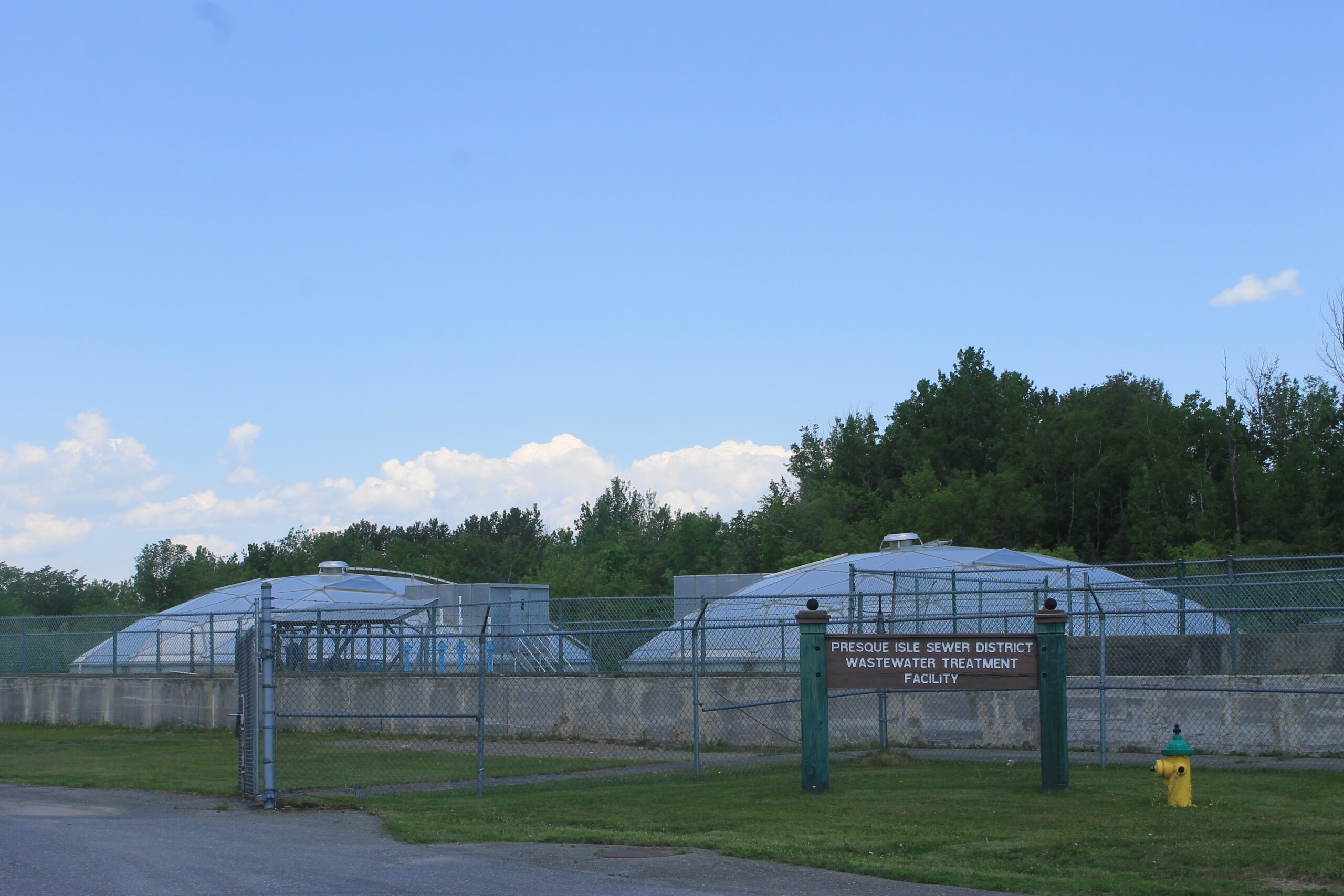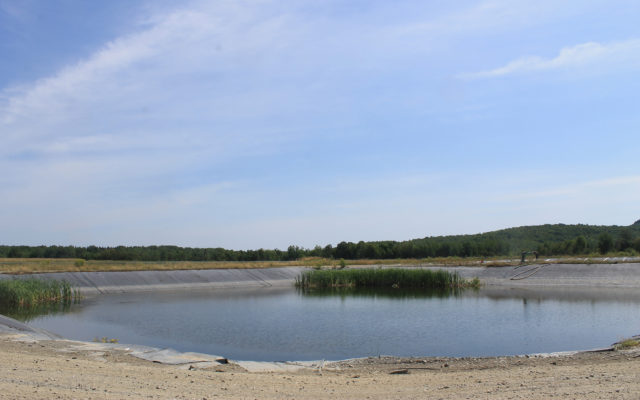
PRESQUE ISLE, Maine — The Presque Isle Utility District and the few people who live along Lathrop and James roads are in the middle of a “very stinky mess,” said utility superintendent Frank Kearney.
Nearly 500,000 gallons of wastewater sludge are sitting in the utility’s lagoons and emitting a highly septic odor. Typically, the sludge would have been spread on the utility’s hayfields in early summer and not present a problem. But due to high levels of the PFOS family of chemicals present in the sludge and field soils, “we have been told we will never spread sludge on our land again,” Kearney said at the utility’s board meeting Aug. 20.
The Presque Isle Utility District is applying for a $15 million USDA Rural Development loan for upgrading its wastewater treatment plant, with more than $1 million that would be geared toward new sludge dewatering infrastructure. Completion of such a project, however, could be three or four years away, while the sludge issue at the lagoons needs to be addressed before winter.
- The Presque Isle Utilities District’s wastewater lagoons off Lathrop Road in Presque Isle. The organization will have to stop spreading wastewater sludge held in the lagoons after soil tests from its hayfields found PFOS chemcials above the state-set threshold. (Staff photo/Anthony Brino)
“We’ve got all options on the table right now,” said Nate McLaughlin, senior project manager with Woodard and Curran, who’s working as a consulting engineer with the Presque Isle Utility District. “How do we blend the immediate need with the funding available that moves us toward the long-term fix? It’s a head-scratcher.”
The utility is also planning to test several residential drinking wells around its hayfields, and has identified contributing sources of the PFOS chemicals to its wastewater treatment plant.
In March, when an Arundel dairy farm found high PFOS levels in its milk and water after years of sludge spreading, the Maine Department of Environmental Protection ordered water utilities and farms to stop spreading wastewater sludge on fields until they tested soils for three chemicals in the PFOS family.
The synthetic chemicals have long been used for fire suppression, non-stick cookware and other industrial and consumer products but have emerged as a public health concern, as they do not readily break down and pose a range of health risks, including cancer.
The Maine DEP set an upper limit of 5.2 parts per billion in soil for PFOS, or perfluorooctanesulfonic acid, and nine out of Presque Isle’s 12 fields had levels ranging from 7.6 parts per billion to 27.8 parts per billion. The other two chemicals — PFBS and PFOA — were mostly under the threshold levels, but the PFOS results nonetheless means the utility can no longer spread sludge.
The Presque Isle Utility District is the only Maine utility that has remained entirely reliant on field spreading to dispose of the “biosolids” or sludge that remain after wastewater treatment. Some other utilities do spread sludge, but also have the ability to remove water from the sludge and truck the solids to landfills, a method that the Presque Isle Utility District is now planning to adopt.
Through the rest of August, McLaughlin, Kearney and others with the utility are going to be deciding whether to spend money on a one-time dewatering service, invest now in permanent dewatering equipment, or perhaps both. One-time dewatering would cost more than $100,000, while dewatering equipment could run $500,000 or more. The utility will have access to a Maine DEP grant that will cover 80 percent of the costs of dewatering up to $150,000, Kearney said.
At the DEP’s urging, the utility is also planning to test the private water wells of nine households within 1,500 feet of the fields.
“I suspect we’ll find PFOS chemicals in all of them,” some of which might be from their septic systems and household waste and some from the sludge spreading, Kearney said.
It’s not clear if the utility would have to cover the costs of addressing any PFOS contamination in the groundwater. PFOS chemicals are relatively simple to remove from clear water through carbon filters, and some communities around the country are adding filtration to their municipal water supply due to past PFOS contamination, McLaughlin said.
Although PFOS chemicals are not regulated at the federal level, the U.S. Environmental Protection Agency has tested for them in some utility drinking water as part of a nationwide randomized sampling program. In 2016, Presque Isle’s drinking water source of river-fed groundwater was tested and it showed no detectable levels of PFOS chemicals, Kearney said.
While the Presque Isle Utility District’s leadership mulls over its options, they do have information on the largest source of the PFOS chemicals entering their wastewater stream.
The utility’s contracted laboratory tested the three main pipe systems that enter the wastewater treatment plant: the east and west sides of Presque Isle home to mostly neighborhoods and retail businesses and the Skyway Industrial Park that also hosts Presque Isle International Airport.
The east side had a “modest amount” of PFOS and the west side had non-detectable amounts, Kearney said. But the pipes coming from the industrial park showed “high levels,” with PFOS at more than 100 parts per billion, Kearney said.
“It probably shouldn’t be news to us,” he told the board. “I can guarantee you [PFOS] was a component of firefighting foam at our municipal airport for decades. The fire department used to practice setting 50 gallons of diesel fuel on fire and putting it out.”
Airports and military bases around the world have long used fire-suppressing foam with PFOS. The chemicals were also extensively used at former Maine military bases like Loring Air Force Base and Brunswick Naval Air Station, although in Presque Isle, the Air Force Base closed before the chemicals were adopted, Kearney said.
While they can be filtered, PFOS chemicals easily enter into groundwater. “They have an affinity for water. It attaches to water and it goes anywhere water goes. That’s why it’s all over the planet,” Kearney said.
The area around the airport and industrial park also has “some of our leakiest pipes,” Kearney said, referring to old wastewater pipes that are subject to infiltration of water draining from the surface.
The utility is in the midst of a multi-year project to replace those pipes, which in the long-term could reduce the levels of PFOS chemicals in the wastewater stream, Kearney said.
In the meantime, the Presque Isle utility has to devise a solution to the sludge issue, while water utilities around the country confront the problem of PFOS in their water supplies, not just the wastewater. According to a study by the Environmental Working Group, more than 600 drinking water utilities serving 19 million Americans in 43 states have some level of PFOS contamination.
In Maine, the next PFOS issue that may be confronted is the water collected at landfills, known as leachate, that is usually treated at local water plants before being discharged into waterways.
“This problem isn’t going away,” Kearney said.








